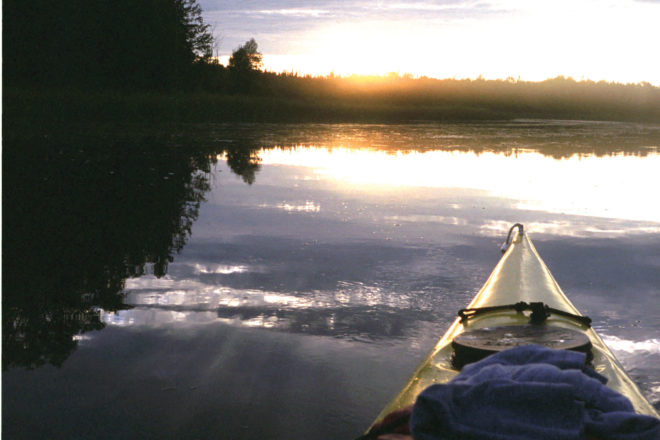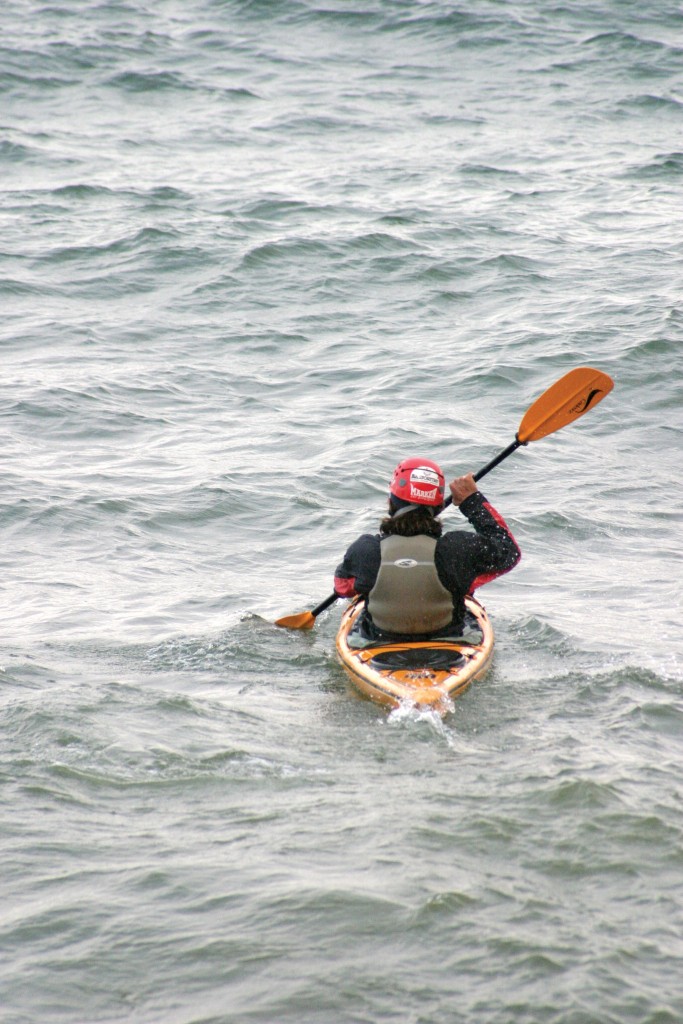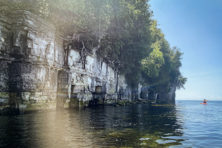Kayaking in the Door: A paddler’s perspective
- Share
- Tweet
- Pin
- Share

The morning sun has just peaked over the tree line, the water is golden glass, and the air is suspended in silent haze. My kayak is resting on the car rack, paddle between the seats, and the PFD, skirt, bilge pump, and paddle float are tucked in the trunk. I assemble my gear, take a few steps on the beach, and with a couple of paddle strokes I’ve escaped to the water. Feeling my physical energy propel me through the environment inspires primeval thoughts; I am free from oil, gas fumes, and electronics.
Snaking smoke from campfires in Peninsula State Park drifts softly through the trees and over Nicolet Bay’s deserted beach. I pass Eagle Bluff taking in the deep and ancient sea caves. As I approach the north side of Horseshoe Island, a six-foot wingspan fills my eyes as a bald eagle glides towards the water. The eagle retreats back into the sky and lands on a white pine limb that reaches out high above the water. I float beneath the limb and look up into the eagle’s eyes with awe. I drift by without disturbing it and paddle around the island. Gulls and terns glide by me scanning the water for a meal, and swallows perform aerial stunts as they dine on insects. The sun has burned through the morning haze and as I paddle back to the beach I cannot imagine a better start to the day.
Sitting four inches above the water’s surface in a kayak presents a unique perspective of the landscape both above and below the water. Once the motion of paddling becomes a rhythmic routine, your mind begins to focus in on the details of the environment: puffs of wind across the water’s surface, frenzies of tiny insect swarms, natural etchings on the shoreline, various patterns of bird flights, and sways of aquatic plants.
Paddling one spring afternoon near Toft’s Point I spotted a cloud of birds in the distance that flew together in and out from the shoreline. I paddled closer to discover that the cloud consisted of about seventy-five Dunlin sandpipers on their way to breed in the arctic. Their perfectly synchronized take offs, wing flaps, and landings created a mesmerizing rhythm of flight.

Door County has so many beautiful places to paddle, and deciding where to go is best determined by the weather, wind, and the paddler’s mood. In general the Green Bay side has warmer water temperatures and is calm when the wind is out of the east. The Lake Michigan side has colder water temperatures and the shoreline is calm when the wind is out of the west. The inland lakes, Europe, Kangaroo, and Clarks, are the best places for beginners to practice or for experts to enjoy a relaxing paddle. Although the wind and waves can pick up on these lakes, they are usually fairly calm with much warmer water temperatures. For paddlers who are interested in wildlife viewing, the Mink River is an excellent destination, but low water levels make it difficult to find a navigable channel into the river. Newport State Park in Ellison Bay is also a great place for bird watching and wildlife viewing.
For experienced paddlers that like to go extreme and surf the big Lake Michigan waves, one of the best spots is Moonlight Bay when the wind blows from the northeast onto the submerged rock ledges. Be confident in your bracing techniques before surfing over these ledges. Cave Point is another tricky yet beautiful paddle that is best attempted by experienced paddlers or by beginners on a guided tour. On calm days the current low water levels permit passes through several caves in a kayak. However, the wind and waves change quickly in this part of the lake and the water temperature can be below fifty degrees even in the middle of summer.

Kayaking is a sport in which safety must always be the highest priority. The best way to learn about the basic skills and essential safety equipment is to go on a guided tour. There are several kayak outfitters and guided tours offered in Door County. On most tours you can expect to be introduced to the following basics:
- Proper use and care of equipment (kayak, paddle, personal floatation device, spray skirt, paddle float, and bilge pump).
- Paddling techniques, including a few tips on efficiency and comfort
- Safety considerations and equipment
- Rescue techniques
In northern Door County the Bayshore Outdoor Store in Sister Bay offers guided tours and kayak rentals. In southern Door the Team Leadership Center in Institute offers guided tours and private lessons. Tours with both outfits include kayak rentals. The Ephraim Sailing Center and the Nicolet Beach Rentals in Peninsula State Park offer kayak rentals for the Nicolet Bay and Eagle Harbor areas.
Bayshore Outdoor Store (920) 854-7598
www.kayakdoorcounty.com
Team Leadership Center (920) 746-9999
www.teamleadership.com
Ephraim Sailing Center (920) 854-4336
Nicolet Beach Rentals (920) 854-9220

The water in Door County is unusually clear thanks to the fingernail size zebra mussel. This exotic, invasive species was introduced to the Great Lakes in 1988 from foreign ships’ ballast water. These mussels originate from the Caspian Sea of Asia and have been spread by humans to all of the Great Lakes and many rivers and inland lakes. Along with causing nasty cuts on swimmers’ feet, Zebra mussels disrupt the entire aquatic food chain by consuming microscopic plants and invertebrates, negatively impacting the fish population. Zebra mussels also clog water intake pipes. An estimation made by the U.S. Fish and Wildlife Service predicts that zebra mussels will cost U.S. and Canadian water users within the Great Lakes region five billion dollars over the next ten years. A method for eliminating zebra mussels has not been found, so the focus of conservationists has been on reducing and limiting the spread to inland lakes and waterways. It is essential to make sure that all boats are free of zebra mussels and plant debris before they are launched into a new body of water.





